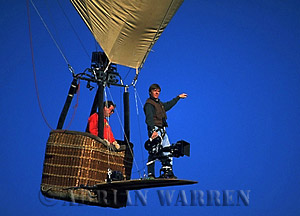There are many difficulties and disadvantages associated with the use of balloons for aerial photography, but when a balloon works successfully, the result can be visually very satisfying. It is the ultimate in smooth aerial platforms and there is no need to over crank the camera to smooth out bumps or aircraft vibration. There is also time to consider a shot more carefully, and there is the potential to fly low enough to skim the grass blades.
Now for the problems: Balloons are severely restricted by weather. It is difficult, and uncomfortable, to take off or land in windy conditions. In tropical areas, it can be dangerous to fly during the heat of the day when a turbulent thermal can toss the aircraft about alarmingly, or, worse still, suck a lot of the air out of the envelope. Balloons cannot choose where to fly - they go where the wind blows them, which not only means you can't go around for a second chance at a shot, but landing areas need to be planned well ahead of time. Balloons are not available everywhere, and, even where they are, they are expensive, and time consuming, requiring a ground crew with a vehicle suitable for the terrain and large enough to accommodate all the equipment. The difficulties in recovery in remote areas cannot be over estimated, either. And if you are planning to film animals from the air, a balloon is not the most suitable platform - they will run away from you as fast as they can if you are at low level, and if you go higher, there is always the possibility that the wind will carry you on a course that carries you and your balloon out of range of that huge herd of wildebeest that you thought you could not miss when you assessed the ground wind before take off.
If you simply want landscapes, and recovery is not a problem, then balloons can provide an exciting way of getting some interesting shots. Don't limit yourself, though, to placing the camera in the basket on a conventional tripod or clamped mount on the side of the basket. If you do, the camera will be too high for those dramatic ground skimming shots.

(Balloon camera platform in Etosha, Namibia)
For the film ETOSHA, in "The Living Edens" series for ABC/Kane, we built a camera platform outside the basket which was hinged so it could be stowed neatly for take-off and landing; but, when deployed, provided a comfortably large enough surface to walk around on, with a 35 mm camera mounted on a high hat. The platform, made from marine plywood, was suspended from the balloon burner frame by thin steel cables, and more steel cables provided safety lines for both the camera and operator. If you would like further information on this technique, please contact us at Last Refuge Ltd.
Camera harnesses on animals. Video cameras are now so small (no larger than a fingernail, including lens) and light enough to permit mounting on a specially designed harness for animals. Pictures from the video camera can be transmitted to a receiver. It should be noted, however, that this kind of activity can cause extreme stess to the animal concerned, unless it is specially trained for the purpose; and, in any case, the welfare of the animal should always be more important than your pictures. Special permits are required for working with animals.
